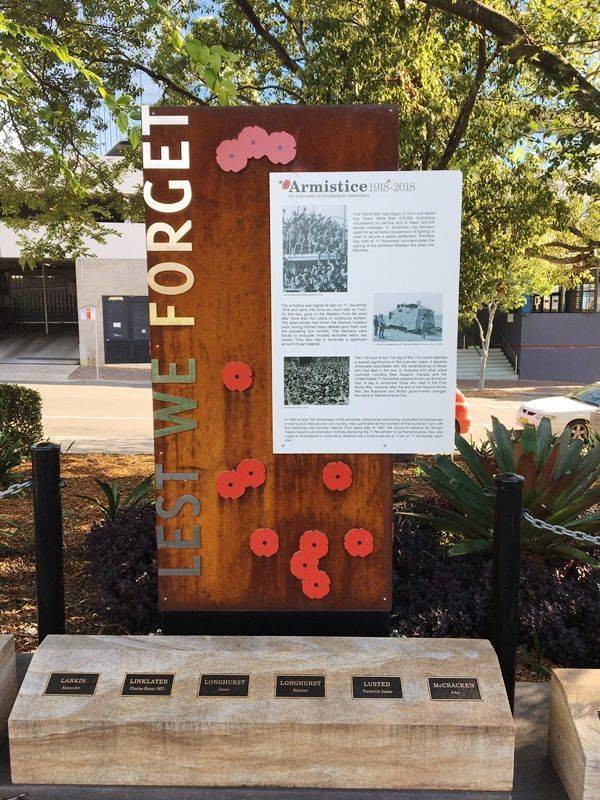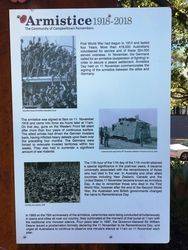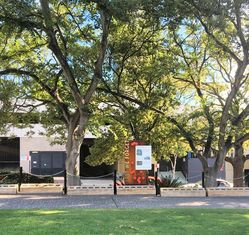
Home » Themes » Conflict » World War One
Armistice Centenary MemorialPrint Page 
The memorial commemorates the centenary of Armistice and those who served in World War One. It is part of the Federal Armistice Centenary Grant Program. The Armistice on the 11th November 1918 bought to an end four years of brutal conflict which took the lives of almost 62,000 Australians.
The Armistice Centenary Memorials are a permanent mark of respect and recognition of the sacrifices made by the Australians who served in World War One, as well as the contributions made by their families, friends and other Australians at home during the conflict.
Each memorial consists of a corten steel body with cut outs of aluminium poppies, known as the flowers of remembrance, painted in red and with a halo light effect around them. The left side of the memorials feature the words Lest We Forget in aluminium letter cut outs. A graphics panel on the right side of the memorials includes a brief history of Armistice Day and photos from World War One.
Note: An Armistice Centenary Memorial is also located Ingleburn’s Milton Park.
Location
| Address: | Queen & Cordeaux Streets, Mawson Park, Campbelltown, 2560 |
|---|---|
| State: | NSW |
| Area: | AUS |
| GPS Coordinates: | Lat: -34.065783 Long: 150.815817 Note: GPS Coordinates are approximate. |
Details
| Monument Type: | Monument |
|---|---|
| Monument Theme: | Conflict |
| Sub-Theme: | WW1 |
| Actual Event Start Date: | 11-November-1918 |
| Actual Event End Date: | 11-November-2018 |
Dedication
| Actual Monument Dedication Date: | Sunday 11th November, 2018 |
|---|
LEST WE FORGET
Armistice 1918 - 2018
The community of Campbelltown remembers
First World War had begun in 1914 and lasted four years. More than 416,000 Australians volunteered for service and of those 324,000 served overseas. In November, the Germans called for an armistice (suspension of fighting) in order to secure a peace settlement. Armistice Day held on 11 November commemorates the signing of the armistice between the allies and Germany.
The armistice was signed at 5am of 11 November 1918 and came into force six hours later at 11am. On that day, guns on the Western Front fell silent after more than four years of continuous warfare. The allied armies had driven the German invaders back, having inflicted heavy defeats upon them over the preceding four months. The Germans were forced to evacuate invaded territories within two weeks. They also had to surrender a signficant amount of war material.
The 11th hour of the 11th day of the 11th month attained a special significance in the post-war years. It became universally associated with the remembrance of those who had died in the war. In Australia and other allied countries including New Zealand, Canada and the United States, 11 November became known as Armistice Day. A day to remember those who died in the First World War, however after the end of the Second World War, the Australian and British governments changed the name to Remembrance Day.
In 1993 on the 75th anniversary of the armistice, ceremonies were being conducted simultaneously in towns and cities all over our country, they culminated at the moment of that burial at 11am with the traditional one minutes` silence. Four years later in 1997, the Governor-General Sir William Deane issued a proclamation formally declaring the 11 November to be Remembrance Day, and urged all Australians to continue to observe one minute`s silence at 11am of 11 November each year.







